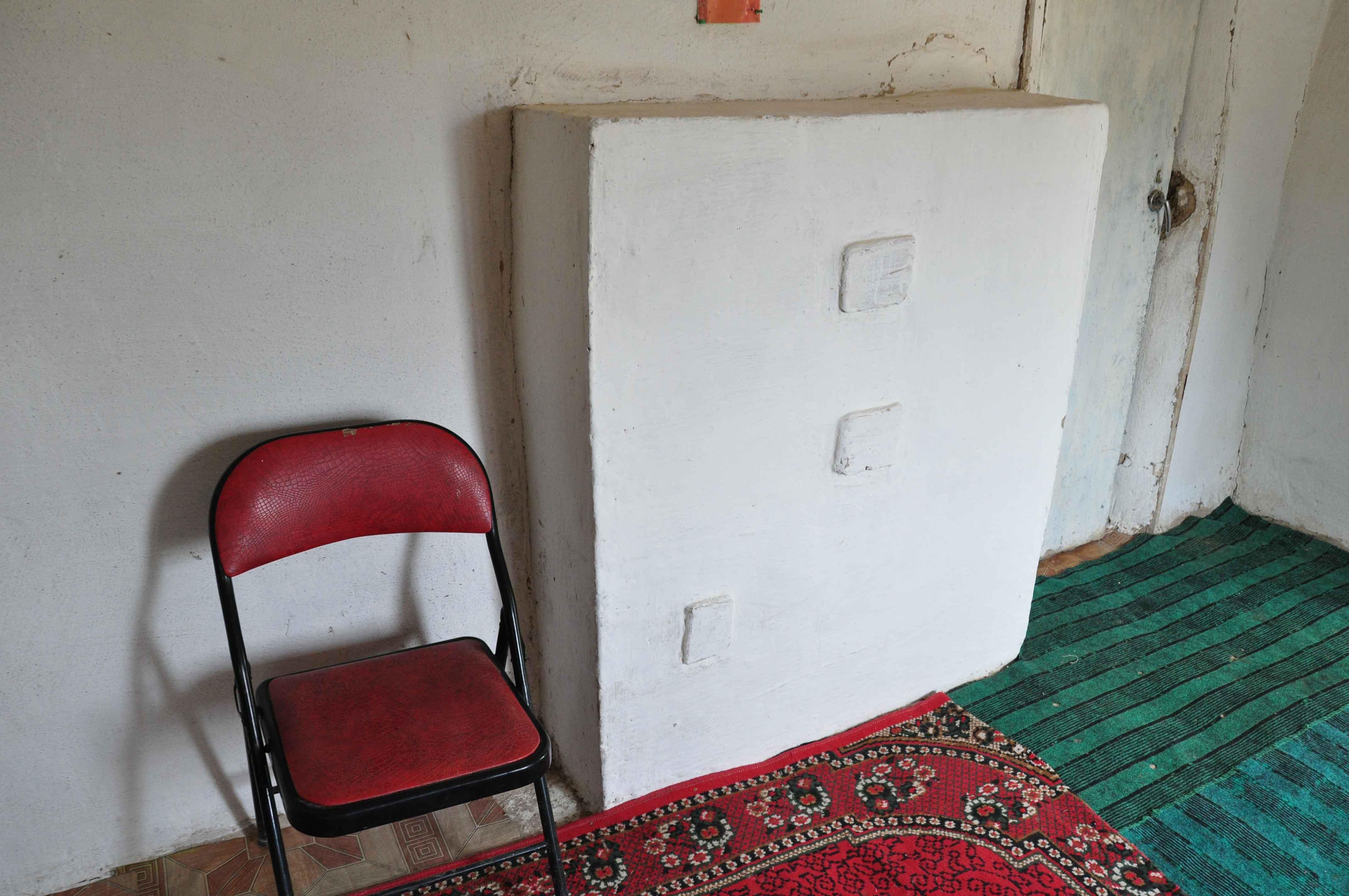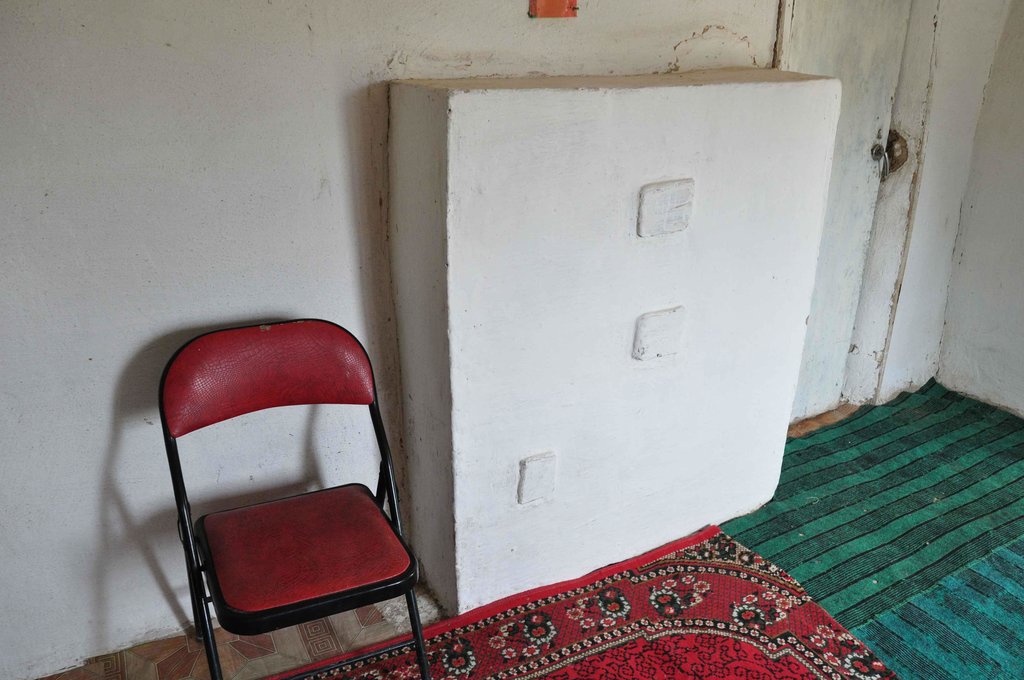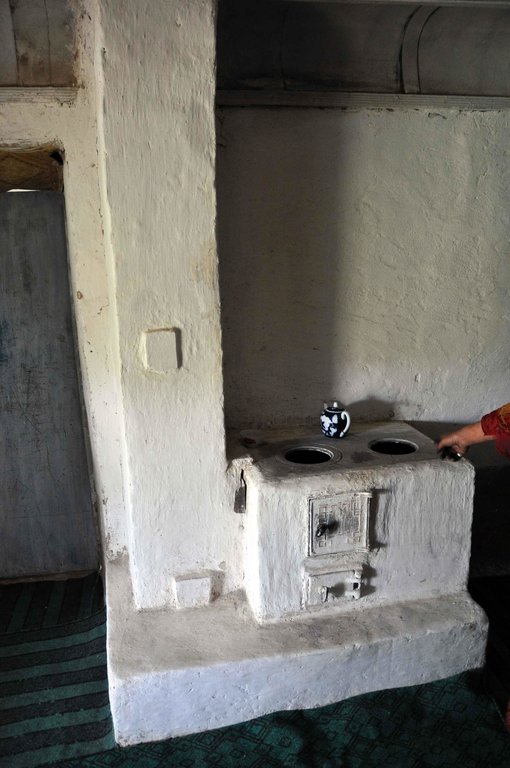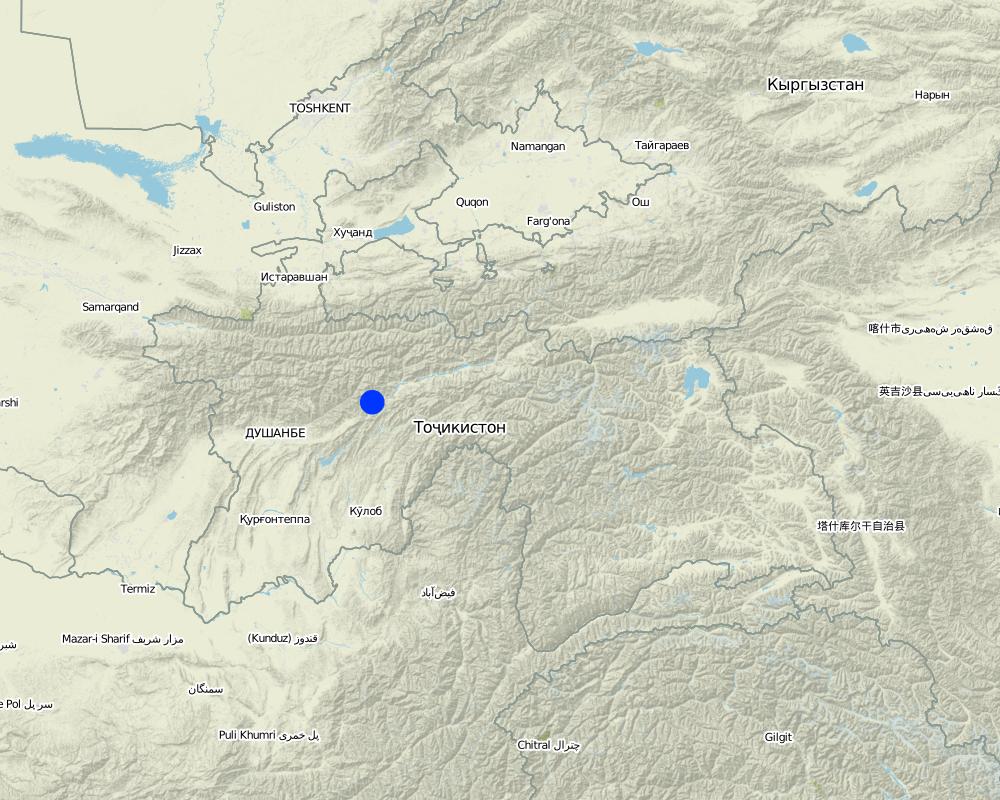Two Room Stove [ทาจิกิสถาน]
- ผู้สร้างสรรค์:
- การอัพเดท:
- ผู้รวบรวม: shane stevenson
- ผู้เรียบเรียง: –
- ผู้ตรวจสอบ: David Streiff, Alexandra Gavilano
technologies_1518 - ทาจิกิสถาน
ดูส่วนย่อย
ขยายทั้งหมด ย่อทั้งหมด1. ข้อมูลทั่วไป
1.2 รายละเอียดที่ติดต่อได้ของผู้รวบรวมและองค์กรที่เกี่ยวข้องในการประเมินและการจัดเตรียมทำเอกสารของเทคโนโลยี
ผู้เชี่ยวชาญ SLM:
Pochoev Mirzokurbon
mirzo_pochoev@camp.tojikiston.com
CAMP
ทาจิกิสถาน
ชื่อขององค์กรซึ่งอำนวยความสะดวกในการทำเอกสารหรือการประเมินเทคโนโลยี (ถ้าเกี่ยวข้อง)
CAMP - Central Asian Mountain Partnership (CAMP - Central Asian Mountain Partnership) - คีร์กีซสถาน1.3 เงื่อนไขการใช้ข้อมูลที่ได้บันทึกผ่านทาง WOCAT
วันที่เก็บรวบรวมข้อมูล(ภาคสนาม) :
11/07/2011
ผู้รวบรวมและวิทยากรหลักยอมรับเงื่อนไขเกี่ยวกับการใช้ข้อมูลที่ถูกบันทึกผ่านทาง WOCAT:
ใช่
1.5 อ้างอิงไปที่แบบสอบถามเรื่องแนวทาง SLM
2. การอธิบายลักษณะของเทคโนโลยี SLM
2.1 การอธิบายแบบสั้น ๆ ของเทคโนโลยี
คำจำกัดความของเทคโนโลยี:
A brick stove that is built into the existing internal wall, that will heat the two rooms and can be used for cooking.
2.2 การอธิบายแบบละเอียดของเทคโนโลยี
คำอธิบาย:
The 2-room stove is a brick based structure that filters hot air into a second room, hence maximising the heating potential of the fuel. The basic stove is built of fire bricks, house bricks, cement and coated with a natural mix of straw and mud. It is a traditional concept based upon former soviet stoves, that was modernised and adapted to improve the energy efficiency, and make use of the materials that are available to the people. It is able to burn coal, wood, and tapac, and is designed to reduce the amount of natural resources used to meet the household energy needs.
Purpose of the Technology: The purpose of the 2-room stove is to replace the traditional cast iron pig style of stove, with a more modern and energy efficient stove that can be used effectively for cooking and the heating of two rooms. The 2-room stove is designed to filter the hot air between the rooms and the use the bricks as a thermal sink for heat retention. As most of the houses are made of mud bricks, the heat from the stove will conduct through the walls, which will act as radiators to emit warmth into the room. The 2-room stove also means that cooking activities can be conducted inside the house in a smoke free environment.
Establishment / maintenance activities and inputs: The stove requires basic training in construction by a skilled technician, however after a three day training course the local trades people are able to build their own stoves with limited supervision. The stove is constructed from 45 fire bricks and 400 household bricks, the hot plate and stove doors are bought second hand from the markets, and metal bars are used to reinforce the structure. There are two smoke vents in the wall between the two rooms to allow the smoke to filter its way along the snake like chimney until it vents through the roof. The final structure is coated in straw and mud which acts as an insulation layer.
Natural / human environment: There is a high reliance on natural resources in Shahtuti Bolo. The average family burns several tons of tapac (straw dung mix) and wood each year. The surrounding mountain area is sparsely vegetated and does not even provide enough fuel for the village during the harsh winter months. This is supplemented by buying wood from the neighbouring villages. One tapac weighs one kilo, this is organic matter that can no longer be used for soil enhancement, but for fuel purposes. It is estimated that the 2-room stove will reduce the amount of fuel burnt by 20-40% depending upon the household.
2.3 รูปภาพของเทคโนโลยี
2.5 ประเทศภูมิภาค หรือสถานที่ตั้งที่เทคโนโลยีได้นำไปใช้และได้รับการครอบคลุมโดยการประเมินนี้
ประเทศ:
ทาจิกิสถาน
ภูมิภาค/รัฐ/จังหวัด:
Hakimi Jamoat, Nurobod
ข้อมูลจำเพาะเพิ่มเติมของสถานที่ตั้ง :
Regional Subordination of Tajikistan
Map
×2.6 วันที่การดำเนินการ
ถ้าไม่รู้ปีที่แน่นอน ให้ระบุวันที่โดยประมาณ:
- น้อยกว่า 10 ปี (ไม่นานนี้)
2.7 คำแนะนำของเทคโนโลยี
ให้ระบุว่าเทคโนโลยีถูกแนะนำเข้ามาอย่างไร:
- ทางโครงการหรือจากภายนอก
ความคิดเห็น (ประเภทของโครงการ เป็นต้น) :
The two room stove is modernisation of a traditional design, therefore the concept is not new to the people.
3. การจัดประเภทของเทคโนโลยี SLM
3.1 วัตถุประสงค์หลักของเทคโนโลยี
- reduce energy
3.2 ประเภทของการใช้ที่ดินในปัจจุบันที่ได้นำเทคโนโลยีไปใช้

ทุ่งหญ้าเลี้ยงสัตว์

การตั้งถิ่นฐาน โครงสร้างพื้นฐาน
- การตั้งถิ่นฐาน ตึกอาคาร
ข้อสังเกต:
The technology is implemented in the households
แสดงความคิดเห็น:
Major land use problems (compiler’s opinion): The over exploitation of natural resources that have lead to soil erosion and degradation of the soil structure.
Major land use problems (land users’ perception): The land has become increasingly unproductive over the last few decades. There is not enough pasture to feed our animals.
Constraints of settlement / urban
3.3 ข้อมูลเพิ่มเติมเกี่ยวกับการใช้ที่ดิน
ระบุ:
Longest growing period in days: 180Longest growing period from month to month: April - October
3.4 กลุ่ม SLM ที่ตรงกับเทคโนโลยีนี้
- ประสิทธิภาพด้านพลังงาน
3.5 กระจายตัวของเทคโนโลยี
ระบุการกระจายตัวของเทคโนโลยี:
- กระจายไปอย่างสม่ำเสมอในพื้นที่
ถ้าหากว่าเทคโนโลยีได้มีการกระจายออกไปอย่างสม่ำเสมอในพื้นที่ ให้ระบุปริมาณพื้นที่ที่ได้รับการครอบคลุมถึง:
- 0.1-1 ตร.กม.
แสดงความคิดเห็น:
The village of Shahtuti Bolo
3.6 มาตรการ SLM ที่ประกอบกันเป็นเทคโนโลยี

มาตรการอนุรักษ์ด้วยโครงสร้าง
- S11: อื่น ๆ
แสดงความคิดเห็น:
Main measures: structural measures
3.7 รูปแบบหลักของการเสื่อมโทรมของที่ดินที่ได้รับการแก้ไขโดยเทคโนโลยี

การกัดกร่อนของดินโดยน้ำ
- Wt (Loss of topsoil): การสูญเสียดินชั้นบนหรือการกัดกร่อนที่ผิวดิน
- Wg (Gully erosion): การกัดกร่อนแบบร่องธารหรือการทำให้เกิดร่องน้ำเซาะ
- Wm (Mass movement): การเคลื่อนตัวของมวลดินหรือดินถล่ม

การกัดกร่อนของดินโดยลม
- Et (Loss of topsoil): การสูญเสียดินชั้นบน

การเสื่อมโทรมของดินทางด้านเคมี
- Cn (Fertility decline): ความอุดมสมบูรณ์และปริมาณอินทรียวัตถุในดินถูกทำให้ลดลงไป (ไม่ได้เกิดจากสาเหตุการกัดกร่อน)

การเสื่อมโทรมของดินทางด้านชีวภาพ
- Bc (Reduction of vegetation cover): การลดลงของจำนวนพืชที่ปกคลุมดิน
- Bh (Loss of habitat): การสูญเสียแหล่งที่อยู่
- Bq (Quantity/biomass decline): การลดลงของปริมาณหรือมวลชีวภาพ
แสดงความคิดเห็น:
Main type of degradation addressed: Wt: loss of topsoil / surface erosion, Wg: gully erosion / gullying, Wm: mass movements / landslides, Et: loss of topsoil, Cn: fertility decline and reduced organic matter content, Bc: reduction of vegetation cover, Bh: loss of habitats
Secondary types of degradation addressed: Bq: quantity / biomass decline
Main causes of degradation: soil management (Failure to use organic fertilisers), deforestation / removal of natural vegetation (incl. forest fires) (Removal of natural resources to meet local energy needs.), over-exploitation of vegetation for domestic use (as above), overgrazing (Areas became over grazed as productivity declined), disturbance of water cycle (infiltration / runoff) (removal of vegetation leads to increased run off from the mountain slopes.), poverty / wealth (There is a lack of money for investment), labour availability (Two thirds of the households in the village have people working abroad.), war and conflicts (There has been substantial political unrest in the area.)
Secondary causes of degradation: Heavy / extreme rainfall (intensity/amounts) (There is a perception that there are more extreme rainfall events.), population pressure (Popualtion in the area is increasing), education, access to knowledge and support services (Lack of knowledge on good land management.)
3.8 การป้องกัน การลดลง หรือการฟื้นฟูความเสื่อมโทรมของที่ดิน
ระบุเป้าหมายของเทคโนโลยีกับความเสื่อมโทรมของที่ดิน:
- ป้องกันความเสื่อมโทรมของที่ดิน
- ลดความเสื่อมโทรมของดิน
แสดงความคิดเห็น:
Main goals: mitigation / reduction of land degradation
Secondary goals: prevention of land degradation
4. ข้อมูลจำเพาะด้านเทคนิค กิจกรรมการนำไปปฏิบัติใช้ ปัจจัยนำเข้า และค่าใช้จ่าย
4.1 แบบแปลนทางเทคนิคของเทคโนโลยี
ผู้เขียน:
S. stevenson, CAMP Kuhiston, apt19 h 131 Rudaki ave, 734003, Dushanbe
4.2 ข้อมูลจำเพาะด้านเทคนิคและการอธิบายแบบแปลนทางเทคนิค
A simple view of the main part of the stove used for cooking. There are two cast iron doors, the lower is for air circulation and the upper is the combustion chamber for the fuel. There are two hot plates for cooking. The smoke travels from the fire vent towards the chimney and then through a 10cm sq hole to the brick structure on the other side. The smoke snakes it way around the the second structure which acts as a radiator as the bricks warm up. The smoke then returns into the chimney in the main room, heating the chimney as it vents.
Location: Shahtuti Bolo. Nurobod
Date: 13.07.2011
Technical knowledge required for field staff / advisors: high (The technical design requires a high level of knowledge)
Technical knowledge required for land users: moderate (With training the land user would be able to build their own two room stove)
Main technical functions: reduces the amount of dung and wood used as fuel.
Structural measure: 2-room stove
Construction material (other): fire bricks and regular house bricks, covered in mud are the main materials.
4.3 ข้อมูลทั่วไปเกี่ยวกับการคำนวณปัจจัยนำเข้าและค่าใช้จ่าย
ให้ระบุว่าค่าใช้จ่ายและปัจจัยนำเข้าได้รับการคำนวณอย่างไร:
- ต่อหน่วยเทคโนโลยี
โปรดระบุหน่วย:
Stove
ระบุสกุลเงินที่ใช้คำนวณค่าใช้จ่าย:
- ดอลลาร์สหรัฐ
ระบุค่าเฉลี่ยของค่าจ้างในการจ้างแรงงานต่อวัน:
4.00
4.4 กิจกรรมเพื่อการจัดตั้ง
| กิจกรรม | ประเภทของมาตรการ | ช่วงเวลาดำเนินการ | |
|---|---|---|---|
| 1. | Construction of stove | ด้วยโครงสร้าง | any |
| 2. | None | None |
4.5 ค่าใช้จ่ายของปัจจัยนำเข้าที่จำเป็นสำหรับการจัดตั้ง
| ปัจจัยนำเข้า | หน่วย | ปริมาณ | ค่าใช้จ่ายต่อหน่วย | ค่าใช้จ่ายทั้งหมดต่อปัจจัยนำเข้า | %ของค่าใช้จ่ายที่ก่อให้เกิดขึ้นโดยผู้ใช้ที่ดิน | |
|---|---|---|---|---|---|---|
| แรงงาน | Construction of stove | Persons/day | 6.0 | 5.333333 | 32.0 | 100.0 |
| อุปกรณ์ | Tools | pieces | 5.0 | 4.0 | 20.0 | |
| วัสดุสำหรับก่อสร้าง | Bricks | bricks | 400.0 | 0.225 | 90.0 | |
| วัสดุสำหรับก่อสร้าง | Fire bricks | bricks | 45.0 | 1.4 | 63.0 | |
| วัสดุสำหรับก่อสร้าง | Metal bar | bars | 5.0 | 3.4 | 17.0 | |
| วัสดุสำหรับก่อสร้าง | Fire cement | cub m | 3.0 | 8.333333 | 25.0 | |
| วัสดุสำหรับก่อสร้าง | Ceramic tiles | tiles | 24.0 | 1.0 | 24.0 | |
| วัสดุสำหรับก่อสร้าง | Metal cooking plates | plates | 1.0 | 63.0 | 63.0 | |
| วัสดุสำหรับก่อสร้าง | Stove doors | doors | 2.0 | 22.5 | 45.0 | |
| อื่น ๆ | Transports | vans | 1.0 | 50.0 | 50.0 | |
| ค่าใช้จ่ายทั้งหมดของการจัดตั้งเทคโนโลยี | 429.0 | |||||
แสดงความคิดเห็น:
Duration of establishment phase: 1 month(s)
4.6 การบำรุงรักษาสภาพหรือกิจกรรมที่เกิดขึ้นเป็นประจำ
| กิจกรรม | ประเภทของมาตรการ | ช่วงระยะเวลา/ความถี่ | |
|---|---|---|---|
| 1. | Cleaning the stove | ด้วยโครงสร้าง | annually |
4.7 ค่าใช้จ่ายของปัจจัยนำเข้าและกิจกรรมที่เกิดขึ้นเป็นประจำที่ต้องการการบำรุงรักษา (ต่อปี)
| ปัจจัยนำเข้า | หน่วย | ปริมาณ | ค่าใช้จ่ายต่อหน่วย | ค่าใช้จ่ายทั้งหมดต่อปัจจัยนำเข้า | %ของค่าใช้จ่ายที่ก่อให้เกิดขึ้นโดยผู้ใช้ที่ดิน | |
|---|---|---|---|---|---|---|
| แรงงาน | Cleaning the stove | Persons/day | 1.0 | 4.0 | 4.0 | 100.0 |
| ค่าใช้จ่ายทั้งหมดของการบำรุงรักษาสภาพเทคโนโลยี | 4.0 | |||||
แสดงความคิดเห็น:
The costs are based upon 2011 prices and are based on constructing only one stove.
4.8 ปัจจัยสำคัญที่สุดที่มีผลกระทบต่อค่าใช้จ่าย
ปัจจัยสำคัญที่สุดที่มีผลกระทบต่อค่าใช้จ่ายต่างๆ:
The main cost is the fire bricks. These have to be transported from the capital. However, in some regions of Tajikistan, materials are available from stoves that were constructed several decades ago which could be reused.
5. สิ่งแวดล้อมทางธรรมชาติและของมนุษย์
5.1 ภูมิอากาศ
ฝนประจำปี
- < 250 ม.ม.
- 251-500 ม.ม.
- 501-750 ม.ม.
- 751-1,000 ม.ม.
- 1,001-1,500 ม.ม.
- 1,501-2,000 ม.ม.
- 2,001-3,000 ม.ม.
- 3,001-4,000 ม.ม.
- > 4,000 ม.ม.
เขตภูมิอากาศเกษตร
- กึ่งแห้งแล้ง
Thermal climate class: temperate
5.2 สภาพภูมิประเทศ
ค่าเฉลี่ยความลาดชัน:
- ราบเรียบ (0-2%)
- ลาดที่ไม่ชัน (3-5%)
- ปานกลาง (6-10%)
- เป็นลูกคลื่น (11-15%)
- เป็นเนิน (16-30%)
- ชัน (31-60%)
- ชันมาก (>60%)
ธรณีสัณฐาน:
- ที่ราบสูง/ที่ราบ
- สันเขา
- ไหล่เขา
- ไหล่เนินเขา
- ตีนเนิน
- หุบเขา
ระดับความสูง:
- 0-100 เมตร
- 101-500 เมตร
- 501-1,000 เมตร
- 1,001-1,500 เมตร
- 1,501-2,000 เมตร
- 2,001-2,500 เมตร
- 2,501-3,000 เมตร
- 3,001-4,000 เมตร
- > 4,000 เมตร
ให้ระบุถ้าเทคโนโลยีได้ถูกนำไปใช้:
- ไม่เกี่ยวข้อง
5.3 ดิน
ค่าเฉลี่ยความลึกของดิน:
- ตื้นมาก (0-20 ซ.ม.)
- ตื้น (21-50 ซ.ม.)
- ลึกปานกลาง (51-80 ซ.ม.)
- ลึก (81-120 ซ.ม.)
- ลึกมาก (>120 ซ.ม.)
เนื้อดิน (ดินชั้นบน):
- หยาบ/เบา (ดินทราย)
อินทรียวัตถุในดิน:
- ต่ำ (<1%)
(ถ้ามี) ให้แนบคำอธิบายเรื่องดินแบบเต็มหรือระบุข้อมูลที่มีอยู่ เช่น ชนิดของดิน ค่า pH ของดินหรือความเป็นกรดของดิน ความสามารถในการแลกเปลี่ยนประจุบวก ไนโตรเจน ความเค็ม เป็นต้น:
Soil fertility is low - medium
Soil drainage / infiltration is poor
Soil water storage capacity is low-medium
5.4 ความเป็นประโยชน์และคุณภาพของน้ำ
ระดับน้ำใต้ดิน:
<5 เมตร
น้ำไหลบ่าที่ผิวดิน:
ไม่ดีหรือไม่มีเลย
คุณภาพน้ำ (ที่ยังไม่ได้บำบัด):
เป็นน้ำเพื่อการดื่มที่ไม่ดี (จำเป็นต้องได้รับการบำบัด)
ความคิดเห็นและข้อมูลจำเพาะเพิ่มเติมเรื่องคุณภาพและปริมาณน้ำ:
Availability of surface water: is good for the village because there is a stream and medium for other areas which have access to te stream.
5.5 ความหลากหลายทางชีวภาพ
ความหลากหลายทางชนิดพันธุ์:
- ต่ำ
5.6 ลักษณะของผู้ใช้ที่ดินที่นำเทคโนโลยีไปปฏิบัติใช้
รายได้ที่มาจากนอกฟาร์ม:
- 10-50% ของรายได้ทั้งหมด
ระดับของความมั่งคั่งโดยเปรียบเทียบ:
- ยากจนมาก
- จน
เป็นรายบุคคล/ครัวเรือน:
- เป็นรายบุคคล/ครัวเรือน
เพศ:
- หญิง
- ชาย
ระบุลักษณะอื่นๆที่เกี่ยวข้องของผู้ใช้ที่ดิน:
Land users applying the Technology are mainly disadvantaged land users
Difference in the involvement of women and men: Training is provided on he construction of the stove. This is only attended by men.
Population density: 50-100 persons/km2
Annual population growth: 2% - 3%
80% of the land users are poor and own 95% of the land.
20% of the land users are poor and own 5% of the land.
Off-farm income specification: 44 out of the 58 households are reliant on remittances from Russia, however all the families have livestock which they buy and sell in the local markets and a small household plot for vegetables.
5.7 พื้นที่เฉลี่ยของที่ดินที่เป็นเจ้าของหรือเช่าโดยผู้ใช้ที่ดินที่นำเทคโนโลยีไปปฏิบัติใช้
- < 0.5 เฮกตาร์
- 0.5-1 เฮกตาร์
- 1-2 เฮกตาร์
- 2-5 เฮกตาร์
- 5-15 เฮกตาร์
- 15-50 เฮกตาร์
- 50-100 เฮกตาร์
- 100-500 เฮกตาร์
- 500-1,000 เฮกตาร์
- 1,000-10,000 เฮกตาร์
- >10,000 เฮกตาร์
พิจารณาว่าเป็นขนาดเล็ก กลาง หรือขนาดใหญ่ (ซึ่งอ้างอิงถึงบริบทระดับท้องถิ่น):
- ขนาดเล็ก
5.8 กรรมสิทธิ์ในที่ดิน สิทธิในการใช้ที่ดินและสิทธิในการใช้น้ำ
กรรมสิทธิ์ในที่ดิน:
- รัฐ
สิทธิในการใช้ที่ดิน:
- เกี่ยวกับชุมชน (ถูกจัดระเบียบ)
แสดงความคิดเห็น:
Four people have the majority of the land user rights in a village of 58.
5.9 การเข้าถึงบริการและโครงสร้างพื้นฐาน
สุขภาพ:
- จน
- ปานกลาง
- ดี
การศึกษา:
- จน
- ปานกลาง
- ดี
ความช่วยเหลือทางด้านเทคนิค:
- จน
- ปานกลาง
- ดี
การจ้างงาน (เช่น ภายนอกฟาร์ม):
- จน
- ปานกลาง
- ดี
ตลาด:
- จน
- ปานกลาง
- ดี
พลังงาน:
- จน
- ปานกลาง
- ดี
ถนนและการขนส่ง:
- จน
- ปานกลาง
- ดี
น้ำดื่มและการสุขาภิบาล:
- จน
- ปานกลาง
- ดี
บริการด้านการเงิน:
- จน
- ปานกลาง
- ดี
6. ผลกระทบและสรุปคำบอกกล่าว
6.1 ผลกระทบในพื้นที่ดำเนินการ (On-site) จากการใช้เทคโนโลยี
ผลกระทบทางด้านเศรษฐกิจและสังคม
การผลิต
การผลิตพืชผล
การผลิตไม้
การผลิตพลังงาน
แสดงความคิดเห็น/ระบุ:
Improved cooking conditions i.e. no smoke.
รายได้และค่าใช้จ่าย
ภาระงาน
ผลกระทบทางด้านเศรษฐกิจและสังคมอื่น ๆ
Demand on natural resources
แสดงความคิดเห็น/ระบุ:
On average around 30% reduction
ผลกระทบด้านสังคมวัฒนธรรมอื่น ๆ
สถานการณ์ด้านสุขภาพ
แสดงความคิดเห็น/ระบุ:
Do not need to cook outside and improve the internal living conditions.
สถาบันของชุมชน
แสดงความคิดเห็น/ระบุ:
Leaves natural resources for the community benefit.
การบรรเทาความขัดแย้ง
แสดงความคิดเห็น/ระบุ:
Helps prevent inter village conflicts over natural resources.
สถานการณ์ของกลุ่มด้อยโอกาส ทางด้านสังคมและเศรษฐกิจ
แสดงความคิดเห็น/ระบุ:
The project is targeted at the most vulnerable in the community.
Livelihood and human well-being
แสดงความคิดเห็น/ระบุ:
It has reduced the time, effort and money spent on fuel whcih can be up to 50% of the household's budget in extreme cases. It has improved the heating in the household and created a smoke free environment for cooking.
ผลกระทบด้านนิเวศวิทยา
ดิน
สิ่งปกคลุมดิน
ความหลากหลายทางชีวภาพของพืชและสัตว์
มวลชีวภาพ/เหนือดินชั้น C
แสดงความคิดเห็น/ระบุ:
Reduction in the burning of dung.
6.3 การเผชิญและความตอบสนองของเทคโนโลยีต่อการเปลี่ยนแปลงสภาพภูมิอากาศที่ค่อยเป็นค่อยไป และสภาพรุนแรงของภูมิอากาศ / ภัยพิบัติ (ที่รับรู้ได้โดยผู้ใช้ที่ดิน)
การเปลี่ยนแปลงสภาพภูมิอากาศที่ค่อยเป็นค่อยไป
การเปลี่ยนแปลงสภาพภูมิอากาศที่ค่อยเป็นค่อยไป
| ฤดู | ประเภทของการเปลี่ยนแปลงสภาพภูมิอากาศที่ค่อยเป็นค่อยไป และสภาพรุนแรงของภูมิอากาศ | เทคโนโลยีมีวิธีการรับมืออย่างไร | |
|---|---|---|---|
| อุณหภูมิประจำปี | เพิ่มขึ้น | ดี |
สภาพรุนแรงของภูมิอากาศ (ภัยพิบัติ)
ภัยพิบัติทางอุตุนิยมวิทยา
| เทคโนโลยีมีวิธีการรับมืออย่างไร | |
|---|---|
| พายุฝนประจำท้องถิ่น | ดี |
| พายุลมประจำท้องถิ่น | ดี |
ภัยพิบัติจากสภาพภูมิอากาศ
| เทคโนโลยีมีวิธีการรับมืออย่างไร | |
|---|---|
| ภัยจากฝนแล้ง | ดี |
ภัยพิบัติจากน้ำ
| เทคโนโลยีมีวิธีการรับมืออย่างไร | |
|---|---|
| น้ำท่วมตามปกติ (แม่น้ำ) | ดี |
ผลลัพธ์ตามมาที่เกี่ยวข้องกับภูมิอากาศอื่น ๆ
ผลลัพธ์ตามมาที่เกี่ยวข้องกับภูมิอากาศอื่น ๆ
| เทคโนโลยีมีวิธีการรับมืออย่างไร | |
|---|---|
| ช่วงการปลูกพืชที่ลดลงมา | ดี |
แสดงความคิดเห็น:
The stove is able to take other fuel sources in the event that natural resources are not available.
6.4 การวิเคราะห์ค่าใช้จ่ายและผลประโยชน์ที่ได้รับ
ผลประโยชน์ที่ได้รับเปรียบเทียบกับค่าใช้จ่ายในการจัดตั้งเป็นอย่างไร (จากมุมมองของผู้ใช้ที่ดิน)
ผลตอบแทนระยะสั้น:
ด้านลบ
ผลตอบแทนระยะยาว:
ด้านบวกอย่างมาก
ผลประโยชน์ที่ได้รับเปรียบเทียบกับค่าใช้จ่ายในการบำรุงรักษาหรือต้นทุนที่เกิดขึ้นซ้ำอีก เป็นอย่างไร (จากมุมมองของผู้ใช้ที่ดิน)
ผลตอบแทนระยะสั้น:
เป็นกลางหรือสมดุล
ผลตอบแทนระยะยาว:
ด้านบวก
แสดงความคิดเห็น:
There is a high initial outlay in the building materials and labour costs, but once the two room stove is constructed it only requires annual cleaning which can be done via hatches already included in the design.
6.5 การปรับตัวของเทคโนโลยี
- 1-10%
ถ้ามีข้อมูลให้บอกปริมาณด้วย (จำนวนของครัวเรือนหรือครอบคลุมพื้นที่):
10 households in an area of 0.1 - 1 km2 (ca. 596 habitants)
จากทั้งหมดที่ได้รับเทคโนโลยีเข้ามามีจำนวนเท่าใดที่ทำแบบทันที โดยไม่ได้รับการจูงใจด้านวัสดุหรือการเงินใด ๆ:
- 0-10%
แสดงความคิดเห็น:
100% of land user families have adopted the Technology with external material support
Comments on acceptance with external material support: All land users given support have constructed a stove. The project will build a further 11 stoves in the local district for the most vulnerable families.
There is no trend towards spontaneous adoption of the Technology
Comments on adoption trend: To early in the project to say, but several memebers of the community are trained to build the stove.
6.7 จุดแข็ง / ข้อได้เปรียบ / โอกาสของเทคโนโลยี
| จุดแข็ง / ข้อได้เปรียบ / โอกาสในทัศนคติของผู้ใช้ที่ดิน |
|---|
|
It keep the house warm and for longer. How can they be sustained / enhanced? Thermal insulation techniques and energy efficiency training may support reduced fuel use. |
| I do not have to cook outside in the winter months. |
| It is easy to clean. |
| จุดแข็ง / ข้อได้เปรียบ / โอกาสในทัศนคติของผู้รวบรวมหรือวิทยากรหลัก |
|---|
|
It improved the household heating system dramatically, as the previous cast iron stove does not retain the heat after the fire dies. How can they be sustained / enhanced? The room could be insulated using traditional techniques or modern materials that are starting to appear on the market. |
|
The brick design will retain the heat for several hours and will heat two rooms. How can they be sustained / enhanced? Doors and windows in the rooms could be sealed to prevent drafts. |
|
The stove will last for 25yrs with minimal maintenance. How can they be sustained / enhanced? If the stove became popular a small brick making factory could be established. |
6.8 จุดอ่อน / ข้อเสียเปรียบ / ความเสี่ยงของเทคโนโลยีและวิธีการแก้ไข
| จุดอ่อน / ข้อเสียเปรียบ / ความเสี่ยงในทัศนคติของผู้ใช้ที่ดิน | มีวิธีการแก้ไขได้อย่างไร |
|---|---|
| It is expensive, and I need an expert to help me. | Remittances could be used to fund the initial set up costs. |
| จุดอ่อน / ข้อเสียเปรียบ / ความเสี่ยงในทัศนคติของผู้รวบรวมหรือวิทยากรหลัก | มีวิธีการแก้ไขได้อย่างไร |
|---|---|
| There is a high initial investment that has required project funding. | Collective building of the stoves will reduce the cost. Micro-finance loans could be made available to help cover the initial costs. |
| The stove requires technical training in its construction. | A booklet could be produced to support self building of the stoves. |
ลิงก์และโมดูล
ขยายทั้งหมด ย่อทั้งหมดลิงก์
ไม่มีลิงก์
โมดูล
ไม่มีโมดูล





